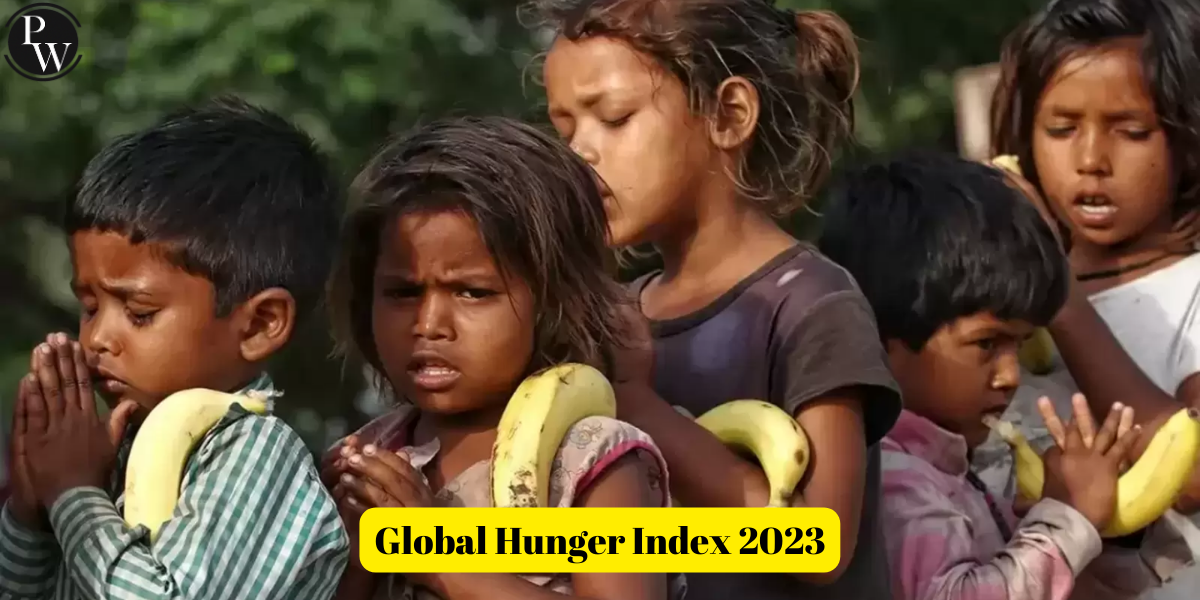

Global Hunger Index 2023
Global Hunger Index 2023: In the latest Global Hunger Index (GHI) for 2023, India has been ranked 111 out of 125 countries, showing a drop from its 107th position in 2022. The GHI, an annual assessment of global hunger levels, is published by Irish NGO Concern Worldwide and German NGO Welt Hunger Hilfe. According to the report, India has the world's highest child wasting rate at 18.7 percent, indicating acute undernutrition.
The rates of undernourishment and under-five mortality in India are reported at 16.6 percent and 3.1 percent, respectively. Furthermore, an alarming 58.1 percent of women aged 15 to 24 in India suffer from anemia.
The overall GHI score for India is 28.7, categorizing the country's hunger situation as "serious." This highlights significant challenges in addressing malnutrition and ensuring adequate food access in the country. Neighboring countries like Pakistan (102nd), Bangladesh (81st), Nepal (69th), and Sri Lanka (60th), have higher scores than India.
What is Global Hunger Index?
The Global Hunger Index (GHI) is an annually published, peer-reviewed report by Concern Worldwide and Welthungerhilfe. It serves as a comprehensive tool to measure and monitor hunger globally, regionally, and nationally, considering various aspects of hunger over time. The GHI score, ranging from 0 (indicating no hunger) to 100 (reflecting the worst hunger severity), is calculated based on four indicators:
- Undernourishment: Represents the portion of the population with insufficient caloric intake.
- Child Stunting: Reflects the percentage of children under five with low height for their age, indicating chronic undernutrition.
- Child Wasting: Indicates the percentage of children under five with low weight for their height, pointing to acute undernutrition.
- Child Mortality: Represents the percentage of children who die before their fifth birthday, influenced partly by inadequate nutrition and unhealthy environments.
Concern Worldwide is an international humanitarian organization committed to addressing poverty and suffering in the world's poorest nations. Welthungerhilfe is a private aid organization in Germany, established in 1962 as the German section of the "Freedom from Hunger Campaign."
The GHI aligns with Sustainable Development Goals (SDGs), with undernourishment being an indicator for SDG 2.1 (ensuring access to safe, nutritious, and sufficient food for all), child stunting and wasting rates as indicators for SDG 2.2 (aiming to end all forms of malnutrition), and the goal of reducing preventable child deaths (SDG 3.2).
Key Points from Global Hunger Index (GHI) 2023
In the latest Global Hunger Index (GHI) for 2023, India is placed at 111 out of 125 countries, and it has a serious level of hunger with a score of 28.7. It's crucial to understand that GHI scores and rankings can only be compared within the same year's report due to changes in data and methods between different years.
India's GHI Score
- India's GHI score in 2023 is 28.7, considered "serious" on the Hunger Scale.
- There's a slight improvement from 2015 (29.2), but it's still a serious situation.
- Compared to alarming scores of 38.4 in 2000 and 35.5 in 2008, India has made significant progress.
Related Data and References
- Child stunting is high at 35.5% (India's NFHS 2019-2021).
- The prevalence of undernourishment is 16.6% (State of Food Security and Nutrition in the World report 2023).
- India's child wasting rate is concerning at 18.7%, the highest among all countries in the report.
- The under-five mortality rate is 3.1% (United Nations Inter-Agency Group for Child Mortality Estimation January 2023).
Global Hunger Trends
- Top-ranked countries with low hunger include Belarus, Bosnia & Herzegovina, Chile, and China.
- Bottom-ranked countries with high hunger include Yemen, Madagascar, and the Central African Republic.
- The world's GHI score for 2023 is 18.3, considered moderate, with minimal improvement since 2015.
- The prevalence of undernourishment has increased from 572 million to approximately 735 million people since 2017.
- The GHI attributes this stagnation to various crises, including climate change, conflicts, economic shocks, the Covid-19 pandemic, and the Russia-Ukraine war, exacerbating social and economic inequalities and hindering progress in reducing hunger worldwide.
Indian Government's Response to GHI 2023
The Ministry of Women and Child Development is critical of the report's method, suggesting it has "serious methodological issues" and "malafide intent." Government data from the Poshan Tracker consistently shows child wasting below 7.2%, conflicting with GHI's figure of 18.7%. The government points out that three out of four GHI indicators focus on children's health, which might not represent the entire population.
Concerns About Sample Size
- The government doubts the accuracy of the "Proportion of Undernourished Population" indicator due to its reliance on a small sample size opinion poll.
Consideration of Complex Factors
- The government argues that factors like stunting and wasting are outcomes of various complex elements, including sanitation, genetics, environment, and food utilization. These are not solely linked to hunger.
- Child mortality, the government notes, may not only result from hunger, indicating other contributing factors.
Global Hunger Index 2023 Other Related Terms
The latest Global Hunger Index (GHI) for 2023 indicates that, despite progress until 2015, the fight against hunger globally has slowed down. The world's GHI score in 2023 is 18.3, considered moderate, and only slightly lower than the 2015 score of 19.1. Since 2017, the number of people experiencing undernourishment, a key factor in GHI calculations, has increased from 572 million to around 735 million.
This suggests a recent trend of more people facing challenges in getting enough food. Below find other terms related to hunger:
Undernourishment
- It means not getting enough calories to stay healthy, as defined by the Food and Agriculture Organization of the United Nations.
- This is based on individual needs considering factors like age, sex, stature, and physical activity.
Undernutrition
- It goes beyond calories and includes deficiencies in energy, protein, and essential vitamins and minerals.
- Undernutrition happens when there's not enough food in terms of both quantity and quality, or poor nutrient use due to infections or illnesses.
Famine
- It's a specific condition defined by the UN under certain conditions:
- When at least 20% of the population faces severe food shortages.
- Acute child malnutrition rates exceed 30%.
- Two out of 10,000 people die daily from starvation or malnutrition-related diseases.
What Factors Contributing to Hunger in India?
Hunger happens when people don't have enough money or access to eat sufficient and nutritious food for a long time, causing discomfort. Reasons include poor healthcare, lack of education, corruption, war, environmental damage, inequality, population growth, low agriculture productivity, economic issues, and social problems.
A survey in India shows many young children face food insecurity, raising worries about their future. To achieve the goal of zero hunger (Sustainable Development Goal 2), India needs strategic actions to ensure everyone has affordable access to healthy food.
Let's check out what factors contributing to hunger in India:
Socioeconomic Disparities and Poverty
- Widespread poverty and differences in wealth are major causes of hunger.
- Poverty results in not having enough food and being unable to afford necessary health services.
Hidden Hunger
- India faces a severe lack of essential micronutrients, known as hidden hunger.
- Poor diet, diseases, and insufficient nutrient intake during pregnancy contribute to this problem.
Inefficient Agricultural Practices and Food Distribution
- Agricultural practices with low yields and losses after harvesting contribute to insufficient food supply.
- Problems in distributing and managing the food supply chain limit access, particularly affecting the poor.
Gender Inequality and Nutritional Disparities
- Unequal access to food within households, with women and girls often receiving less and lower-quality diets, worsens hunger.
- This, combined with the challenges of maternal and child care, increases the risk of chronic undernutrition.
Climate Change and Environmental Stressors
- India is vulnerable to climate change-related issues like changing weather patterns and natural disasters.
- These factors disrupt agriculture, leading to crop failures and a shortage of food.
Lack of Nutritional Program Audits
- Despite planned programs to improve nutrition, there is often little or no auditing at the local level.
- This lack of oversight hinders the effectiveness of nutritional initiatives.
How to Address Hunger in India?
Social Audit and Awareness
- Mandate Audits: Make it compulsory to conduct social audits for the mid-day meal scheme in all districts, involving local authorities.
- Raise Awareness: Increase awareness about nutrition, especially targeting women and children.
- Utilize Technology: Use information technology to monitor programs more effectively.
PDS Enhancement
- Revamp Distribution: Improve the Public Distribution System (PDS) to make the distribution of nutritious food more transparent, reliable, and affordable.
- Benefiting the Disadvantaged: Ensure that enhancements in the system particularly benefit economically disadvantaged individuals.
Reducing Food Waste, Reducing Hunger
- Addressing Wastage: Tackle food wastage by improving warehousing and cold storage facilities.
- International Insight: Learn from the International Institute of Refrigeration's insight—developing countries could save a significant portion of their food supply by having better refrigeration infrastructure.
Mobile Nutritional Clinics
- Remote Area Access: Implement mobile nutritional clinics that reach remote and underserved areas.
- Services Offered: Provide health assessments, dietary counseling, and supplementary feeding for children and pregnant women.
By taking these steps, India can make progress in alleviating hunger and improving overall nutritional well-being.
What is the rank of India in Global Hunger Index 2023?
Who releases the Global Hunger Index 2023?
What is the Hunger Index of India 2013?
What is the rank of India in Global Hunger Index in 2015?
What is the rank of India in Global Hunger Index 2017?












